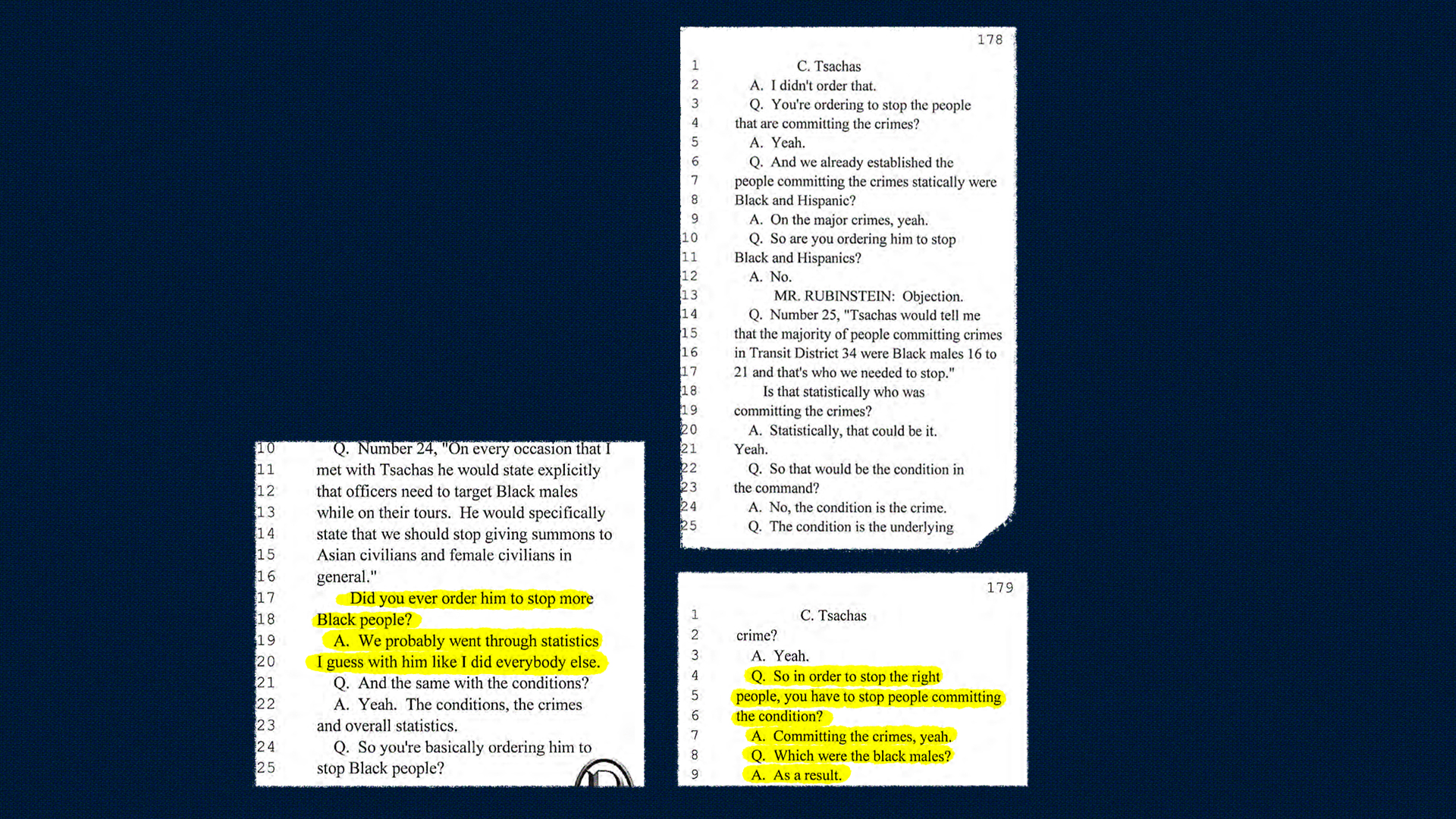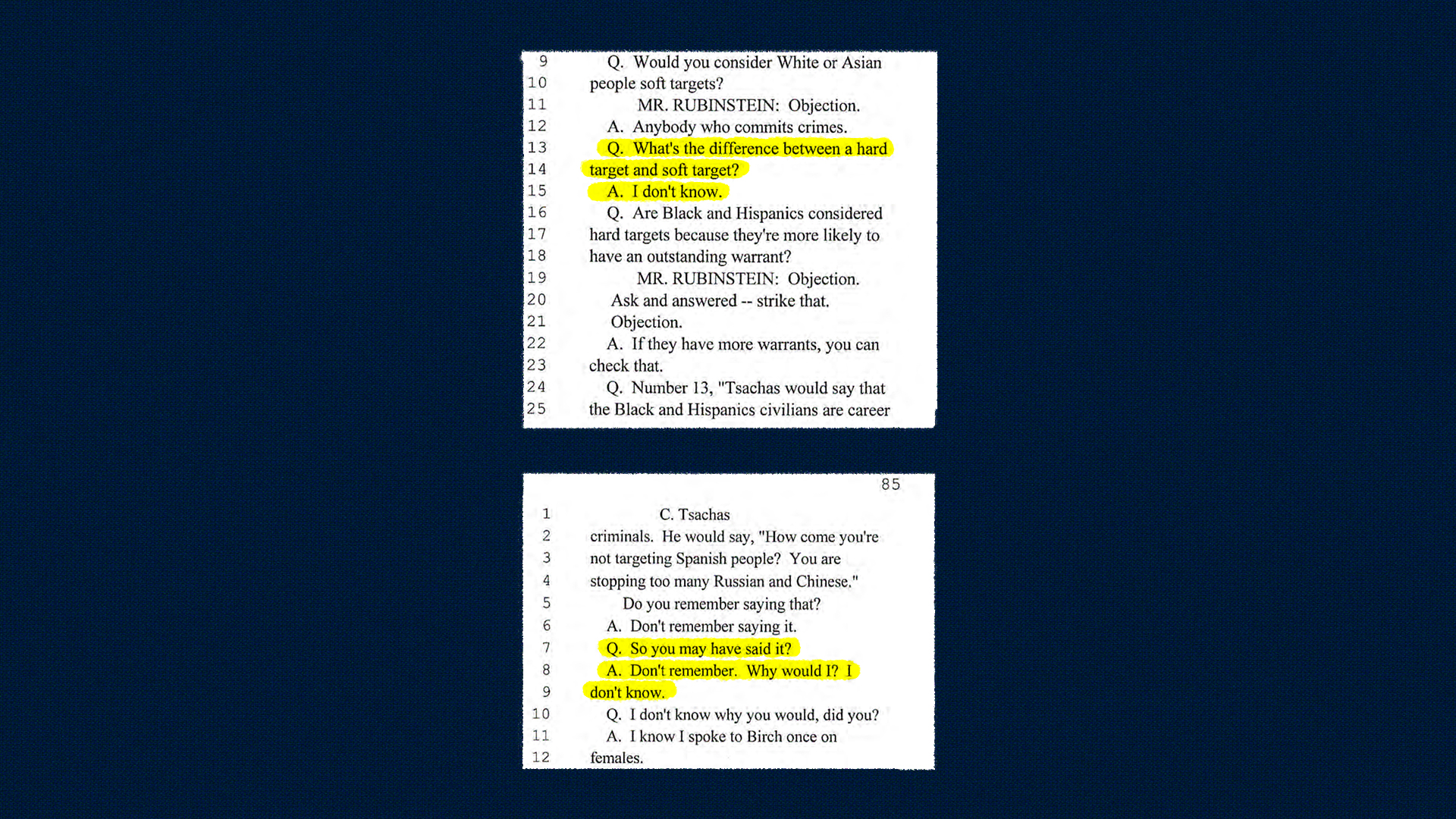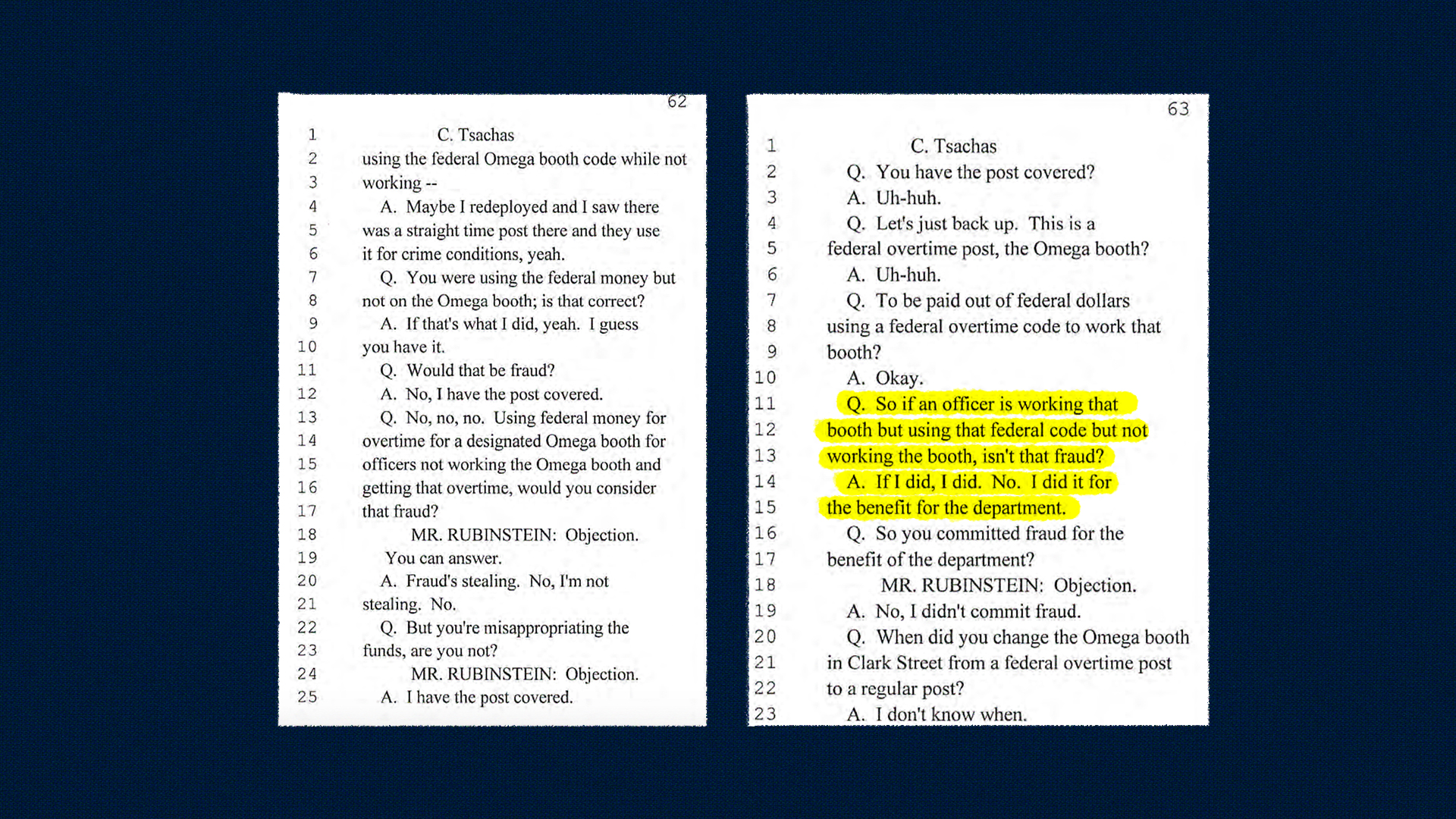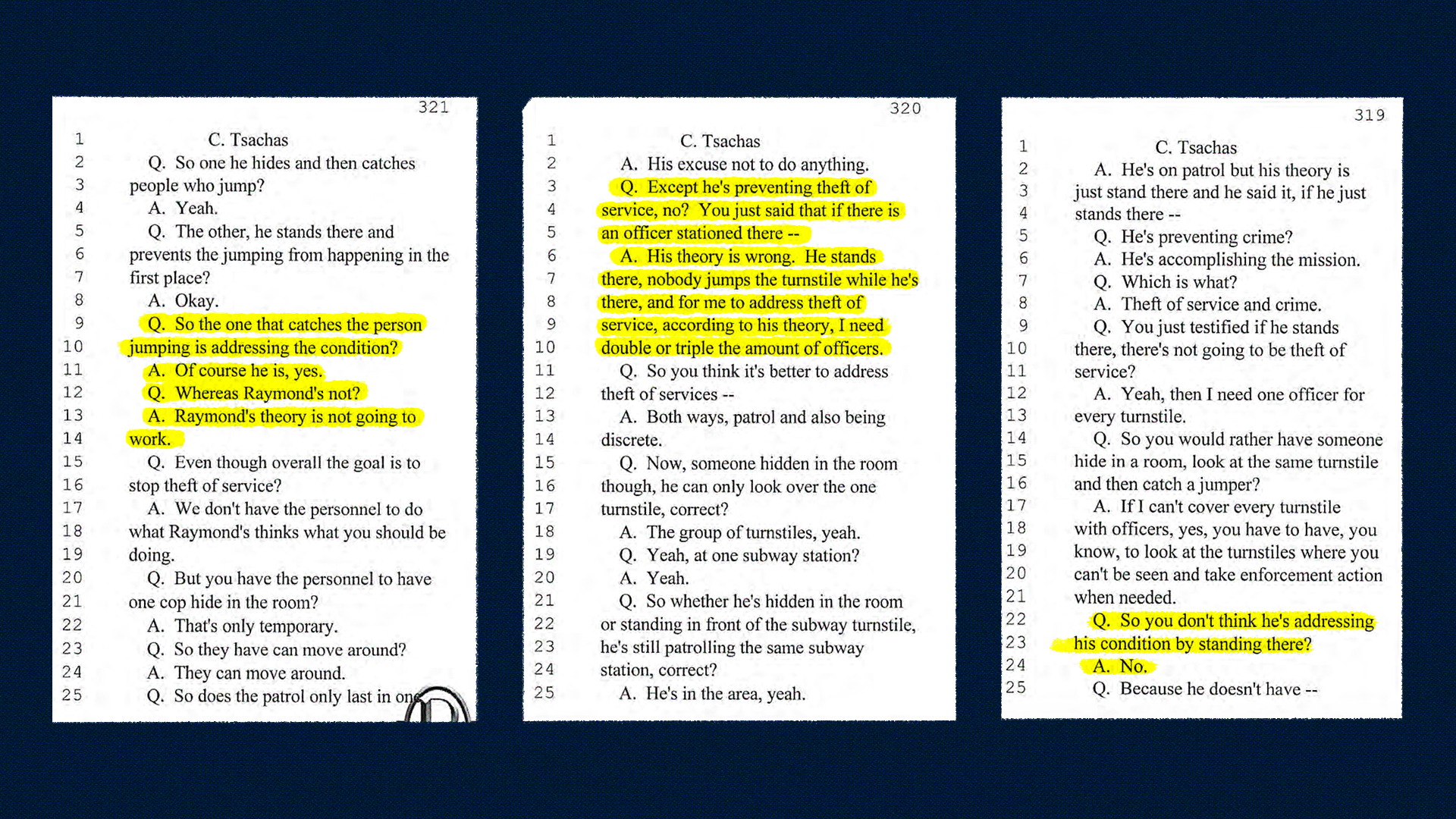On the morning of last October 23, NYPD Deputy Inspector Constantin Tsachas took his place in front of a court reporter at the the New York City Law Department building in downtown Manhattan. The 27-year veteran of the force, who is being sued along with other high-ranking police officers including former police chiefs Bill Bratton and James O’Neill, was being deposed.
At issue was what officers who worked under Tsachas’s command say was a long history of racist policing, and the NYPD’s failure to address it. The four officers bringing the lawsuit—Ritchie Baez, Sandy Gonzalez, Edwin Raymond, and Pedro Serrano—claim they faced discrimination and retaliation for speaking out against an illegal quota system and racist policies.
Videos by VICE
Baez, Gonzalez, and Serrano worked in the 40th Precinct in the Bronx; Raymond worked in Brooklyn in Transit District 32, under Tsachas. He, and eight other former and current police officers who have worked under Tsachas and provided sworn affidavits in support of the plaintiffs, say Tsachas told them to go after “hard targets,” or Black and Latino men, and to let white and Asian men and women generally—”soft targets”—slide. They also say Tsachas punished them for not meeting quotas for arrests and summonses by taking away their overtime and banishing them to the worst posts.
Early in his testimony, when read a line from one of the affidavits saying that Tsachas told officers to “target certain groups of people when they were on patrol” and asked if he ever did that, Tsachas denied it. He then turned dismissive, saying that all the officers making allegations against him sounded the same.
“These guys are all buddies,” Tsachas said, according to a previously unreported transcript of the deposition. “Of course it’s going to sound the same.”
“Or they’re telling the truth,” said John Scola, an attorney for the plaintiffs.
“They’re all buddies,” repeated Tsachas, who over the years has risen through the ranks to be second-in-command of Brooklyn’s transit policing bureau.
Do you work for the NYPD? We’d love to talk to you. Contact the writer from a non-work device at laura.wagner@vice.com or laura.wags@protonmail.com.
In his testimony, Tsachas offered a series of similarly evasive answers to claims that he’d ordered cops to racially profile citizens (“I discussed crime statistics with officers”), enforced quotas for arrest and summonses (“I have expectations”), and gave plum overtime assignments to cops who made more arrests while stripping them from those who didn’t (“They don’t deserve it”).
A union representative for Tsachas has previously denied the allegations against him. A spokesman for the the New York City Law Department, Nicholas Paolucci, told VICE that the claims against Tsachas were “meritless”:
Depositions are part of the legal process and do not by themselves substantiate legal claims. In fact, not a single claim has been substantiated by plaintiffs in this case. The proper venue to defend against the meritless accusations made against our officers in this case is in a court of law, and that’s where we will present our case. Vigorously.
VICE presented the NYPD with the allegations in this story as well as a detailed list of questions; it declined to comment, citing pending litigation. The Captains Endowment Association, the group that represents members at Tsachas’s rank in the NYPD, did not respond.
Tsachas’s deposition, obtained by VICE, offers a rare look at the inner workings of the NYPD. In it, Tsachas defends himself against the suggestion that he misappropriated federal funds by saying he did it “for the benefit of the department”; admits that he did not put white officers who didn’t meet quotas on “performance monitoring,” an NYPD disciplinary track; and acknowledges that he encouraged officers to hide in closets in subway stations in order to catch people hopping turnstiles.
Tsachas defends himself against the suggestion that he misappropriated federal funds by saying he did it “for the benefit of the department” and acknowledges that he encouraged officers to hide in closets in subway stations in order to catch people hopping turnstiles.
In the seven-hour deposition, Scola worked his way through the sworn affidavits of eight different police officers who are not part of the lawsuit but provided affidavits stating that Tsachas ordered them to specifically target Black and Latino men for minor infractions like fare evasion, and punished these officers with poor evaluations, undesirable shifts, or by giving them low evaluations if they didn’t meet quotas.
The testimonies in these affidavits, which were reported on by the New York Times in December, are scathing. Cops who worked under Tsachas in Brooklyn Transit accuse him of harping relentlessly on quotas and taking punitive action against minority officers who didn’t meet them. They say that while arrest quotas existed before Tsachas, the pressure to meet them ramped up dramatically under his leadership, driving morale to new lows. Six of the officers said in their affidavits that Tsachas’s discrimination forced them to retire. One officer even said he warned his son, who is currently serving in the U.S. military and aspires to be a police officer, not to join the NYPD.
In his testimony, Tsachas didn’t so much deny that his orders had a racially-disparate impact as deny that they were motivated by racism, in essence defending his actions by saying that supposedly neutral motivations mattered more than decidedly less than neutral effects.
For instance, after being read a description of a 2010 meeting in which James Hall, the department’s newly-promoted chief of patrol, is said to have told newly-appointed sergeants that he wanted cops making an arrest per month, he denied that this amounted to an increase in the arrest quota, or that there was a quota. (Hall reportedly retired in 2014 to work in the private sector and VICE was unable to reach him for comment; the NYPD declined to comment.) He did allow that after Hall’s promotion there was what Scola described as a “greater emphasis on activity.” In NYPD jargon, a police officer’s “activity” refers to arrests and summons.
“I saw my conditions,” he said, “and I was ready to address them.”
Before working in Brooklyn’s Transit Districts 34 and 32 as a commanding officer, Tsachas enjoyed a long and successful career. Among other things, he oversaw specialized “conditions units” in midtown Manhattan. (“Targeting enforcement in certain problematic areas,” he said, describing their work. “They’re targeting different conditions.”) He also analyzed crime statistics, first on a local level in Queens and then citywide, while working out of police headquarters with the chief of patrol’s office. (“I advise the executive staffs of where the problems are, different conditions,” he said, “like, say, robberies and grand larcenies, where they’re happening, when they’re happening.”)
“A condition,” he said, “is a problem I have to address.”
When addressing the claims of officers who had worked under him and accused him of enforcing illegal quotas, Tscachas explained them in terms of conditions. For instance, he was asked about an affidavit given in July 2019 by Aaron Diaz, a police officer who worked for Tsachas in Transit District 34 and retired from the force in 2018.
“On every occasion that I met with Tsachas,” Diaz said in his affidavit in support of the lawsuit, “he would explicitly state that officers needed to target Black males while on their tours. He would specifically state that we should stop giving summons to Asian civilians and female civilians in general. […] Tsachas would tell me that the majority of people committing crimes in Transit District 34 were Black males 16-21 and that is who we needed to stop.”
Tsachas insisted that he didn’t directly order to Diaz to target Black males. He did agree that the order was “to stop people committing the condition,” who, he said, happened to be Black males:

“[Tsachas] would threaten and punish minority officers for not meeting the quota in a way he did not White Officers who didn’t meet the quota,” said Chris Perez Roman, another officer who worked for Tsachas in District 34 until he retired in 2014, in an affidavit in support of the lawsuit. In his testimony, Tsachas insisted that he punished “everybody the same,” but admitted later in the deposition that he did not put any of the white officers who did not meet their “performance goals” on performance-monitoring plans. He said that this was because they “changed their ways” and started making more arrests and giving more summonses.
“From 2011-2014 I received negative performance evaluations which I always appealed,” Perez Roman said in the affidavit. “Tsachas would base your performance evaluation completely on the number of arrests and summonses you had for the year. […] I would repeatedly ask what the number was that Tsachas wanted us to get which angered Tsachas and he would reply by saying, ‘you know the game.’”
Pierre Maximillian, a Black police officer who worked in Transit District 34 until he retired in 2015, said in his affidavit that the NYPD would use buzzwords to refer to the quota: “The code names include, but are not limited to, productivity indicators, goals, activity, expectation, condition, and/or performance goals.”
In his deposition, Tsachas said quotas were illegal, and that he wasn’t allowed to “dictate a number of arrests.” He did admit, though, that he “had expectations” based on the “amount of arrests” an officer had, and that those expectations were based on conditions:

Christopher LaForce, a Black police officer who worked for Transit District 34 under Tsachas and retired in 2015, said in his affidavit that he did so because he “got tired of hunting Black and Hispanic people because of arrest quotas and dealing with Tsachas’ bigotry.” He said in his affidavit: “After I challenged Tsachas based on his unlawful orders to discriminate through racial profiling, I was retaliated against. Shortly thereafter I was told by my lieutenant that I was having my paid detail and overtime cancelled. This was punishment for my refusal to apply the law the way it is written and my refusal to stop Black people unlawfully.”
When asked in the deposition, with regard to LaForce, if he ever took away someone’s overtime or paid detail for not meeting the condition, Tsachas responded, “Yes.”
“And the condition would be to stop the people committing the crimes, correct?” Scola asked.
“To address conditions, theft of services, crime, yes,” Tsachas said.
LaForce added that his son is serving in the U.S. military and would like to be a police officer when he is finished with his service. “I specifically told him not to join the NYPD due to the manipulation of statistics and pressure on officers to manufacture arrests,” he said in his affidavit.
Felix Benitez, who worked under Tsachas in Transit District 34 and retired in 2014, also said in his affidavit that he felt the pressure to meet arrest quotas. Benitez said that Tsachas specifically didn’t like it when officers stopped Asian civilians. “He would tell us to target Black and Hispanic civilians as they were more likely to ‘pop’ which means have a warrant out for their arrest which would increase arrests within a district.” When asked about this in his deposition, Tsachas responded that he had “discussed crime statistics with officers and that’s it.”

Another officer who worked in Transit District 34 until he retired in 2015, Daniel Perez, said in his affidavit that Tsachas cut his overtime when he learned he was going to retire, ultimately slashing his pension due to the way payouts are calculated. Perez said that his arrests were on par with the rest of the officers in his district; he butted heads with Tsachas, though, over which people he had stopped.
“Tsachas would say that Black and Hispanic civilians are career criminals. He would say, ‘How come you’re not targeting Spanish people? You are stopping too many Russian and Chinese,’” Perez said in his affidavit. “When I responded that I only stopped people who were doing something illegal, Tsachas ordered me to ‘stop Black and Hispanic with tattoos. Tattoos equal career criminals.’”
In the deposition, Tsachas said that he didn’t recall having said that and that it didn’t sound like something he would say—”Tattoos and crime? Stop somebody for a tattoo, that sounds ridiculous”—but couldn’t answer questions about the difference between soft and hard targets.

“Tsachas would require police officers to hide behind subway doors in order to catch fare jumpers,” retired police officer Michael Birch, who worked under Tsachas in TD 34, said in his affidavit. “I don’t believe that a police officer’s job is to hide in a doorway and catch people who jump the turn style [sic]. It is my personal belief that police officers should be visible in order to protect the public and to be a natural deterrent from crime.”
Birch, who describes himself as “white/Hispanic” in his affidavit, separately sued Tsachas, among others, in 2016 over alleged retaliation against him after Birch resisted directives to stop more Black and Latino men. (The judge dismissed the case due to a three-year statute of limitations and a lack of causal connection with respect to his retaliation claims; Birch appealed the ruling and the appeal was denied in February 2017.) Birch also says he recorded a 2012 conversation with Tsachas in which Tsachas told him he should be stopping Black males between the ages of 14 and 21; Gawker published a clip Birch provided them in 2016. (In a statement to the New York Daily News regarding the recording, the Law Department said they would review Birch’s allegations. Nothing seems to have come of it.)
In a recent phone call, Birch told VICE that he’s enjoying retirement and working part-time, but that he still thinks about the NYPD’s problems, which he says he’s “trying to bring to light.” Birch told VICE that captains and commanding officers get promoted based off how many arrests their officers get, which is why, he said, Tsachas encouraged racial profiling.
“These commanders, this is how they get promoted,” he said.
Raymond, the lead plaintiff in the current lawsuit, agreed. “As a commander, no matter how much crime increases, whether or not I’m actually doing anything to target the condition, as long as I simply increase enforcement numbers I will be left alone,” he said. “Pushing my cops to get more numbers and I’ll be fine and I’ll skate off to a promotion and I won’t have to be in the hot seat anymore.”
The lawsuit has been going on for years. In 2015, 12 officers sued the city, alleging that retaliation and discrimination over the use of an illegal quota system for summonses and arrests violated their rights. Known as the NYPD 12, their case garnered local and national attention. (The New York Times Magazine published a profile of Raymond in 2016, and in 2018 filmmaker Stephen Maing released a documentary about the NYPD 12 called Crime and Punishment .)
In 2017, the presiding judge ruled that the claims would be dismissed because officers have to address complaints internally under the statute against quotas and because the plaintiffs hadn’t done enough to show that the defendants acted in a purposefully discriminatory manner or that they were involved in the alleged violations. The judge also ruled, however, that the plaintiffs could replead certain of their claims and bring in additional facts, testimony, and expert reports. This included the retaliation and First Amendment claims brought by four of the officers: Baez, Gonzalez, Raymond, and Serrano. A revised complaint followed, and the parties—including Tsachas—are now in discovery.
The question at the heart of the matter is this: Given a police department that was forced by the courts to end stop-and-frisk because it was violating the constitutional rights of Black and Latino people; that said in 2014 it was going to focus on “collaborative” policing and emphasize the “quality not quantity” of arrests; and that reiterated just two months ago that it is now supposedly, again, focused, under new police commissioner Dermot Shea, on “cultivating deeper bonds with the communities it serves,” how does Constantin Tsachas still have a job?
By the NYPD’s own measures, major crimes in New York City are at an all-time low—lower now than when overtly racist policies like stop-and-frisk were in effect. What does it say about the NYPD’s initiatives if a commander who has been accused by nine officers of pressuring them to target Black and Latino men continues to rise through the ranks?
“It says that the seemingly new direction is smoke and mirrors,” said Raymond. “There is no sincerity behind it and it won’t be incentivized properly.”
The NYPD declined to answer.
When he was working under Tsachas is District 32, Raymond, who is from Brooklyn and has been a part of the NYPD’s “re-engineering” efforts aimed at better helping police protect and serve communities, was, he says, punished for resisting quotas and for his reluctance to hide in subway bathrooms and closets and wait for someone to hop the turnstile so he could jump out and write them a ticket or try to arrest them. One of these punishments, in addition to poor evaluations that threatened to derail his career, was being assigned to the Omega booth.
The Omega booths are small rooms set up in the subway stations that abut tunnels under rivers. They are manned around the clock by police officers who are supposed to watch the tunnels and make sure no one goes in or out, and are usually staffed by police working overtime, funded by the federal government under a program that started after 9/11. According to the deposition, officers working in the Omega booth use a specific code to mark that they worked in the Omega booth. In his testimony, Tsachas admitted that he switched the Omega booth shifts to straight time and used the federal funds to give overtime to preferred cops working on the street—cops he “trusted.”
He denied that this alleged misappropriation of funds was fraud because he was doing it “for the benefit of the department.”

Certainly some officers were benefiting, but Raymond was not. He was stuck in the Omega booth, with few opportunities to arrest anyone or issue summonses. Scola established in the deposition that Raymond was frequently assigned to the Omega booth, while other cops were able to collect overtime out on the street. This ensured that Raymond, a so-called low performing cop, was being set up to fail.
A long portion of the deposition was devoted to essentially breaking down Raymond and Tsachas’s differing philosophies on broken-windows policing, which is epitomized by their approaches to stopping turnstile jumpers. Tsachas wanted officers to hide in closets and bathrooms in the subway and hop out when they saw a fare-beater; Raymond thought cops should remain visible and act as a deterrent, while still being ready to act if needed. Tsachas said, “[Raymond’s] theory is wrong,” because if he followed it he wouldn’t have enough officers to stand in clear view of the turnstiles. Tsachas did allow that he had enough personnel to have cops hide in the subway station rooms, though, he said, “That’s only temporary.”

“The only thing that’s truly respected is enforcement,” Raymond said. “It doesn’t even matter if the enforcement doesn’t meet the objective of correcting the condition as long as summonses are up, arrests are up, and stop-and-frisks are up, the commander has done his job. He has shown that he has tried his best and it is what it is.”
As Tsachas asserted over and over again in his deposition, he has done his job. He got numbers; if doing so required him to stress a quota, well, wasn’t that just part of being a commanding officer? Tsachas targeted his “conditions”; who can blame him if doing so was inherently racist? He is the product of a system that has rewarded enforcement over everything else for decades; according to Raymond, the most salient difference between Tsachas and other NYPD commanders is simply tact.
“He’s not savvy enough to euphemize the objective,” Raymond said. “What he’s saying is the objective, they can’t fire him.”
Tsachas is just one commander, but his approach to policing is indicative of what the NYPD values. In 2016, just months after Gawker and the aforementioned New York Times Magazine profile reported on what were presented as two separate audio recordings of Tsachas pressuring officers to target Black men, Tsachas was promoted to deputy inspector. Birch, who made one of the recordings, told VICE it was a a “slap in the face” to the public. “It was like, ‘Yeah, we know about this racial profiling, and we don’t care,’” he said.
“He’s not savvy enough to euphemize the objective.”
The complaints against Tsachas are, in essence, complaints against how the NYPD has operated for decades, but they’re no less important for that, especially given the recent MTA and NYPD crackdown on fare evasion, the data on which have shown poor Black and Latino neighborhoods are disproportionately affected by enforcement. The complaints against Tsachas also come to bear on the role that NYPD policing strategy is playing in this year’s presidential election. Whichever way the causality runs, with the mayor echoing the cop or the cop echoing the mayor, there is an unmistakable resonance between Tsachas’s testimony and former New York City mayor Michael Bloomberg’s 2015 defense of violent racist policing:
“Ninety-five percent of your murders—murderers and murder victims—fit one M.O.,” he can be heard saying. “You can just take the description, Xerox it and pass it out to all the cops. They are male, minorities, 16 to 25.”
Bloomberg has been desperately trying to distance himself from these comments and from stop-and-frisk in general—in a statement released earlier this month he called it “overused” while passively depicting it as a policy he inherited—but what he said in 2015, is, at its core, the same as what Tsachas’s admitted in his deposition to telling officers in his command when he “discussed crime statistics” with them: Young Black and brown men commit crime; target them with enforcement.
Birch has a theory about why Tsachas still works for the NYPD.
“To fire him now,” he said, “would be an admission that what they did was wrong.”
Follow Laura Wagner on Twitter.




